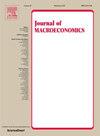Is deflation cause for panic? Evidence from the National Banking era
IF 1.5
3区 经济学
Q3 ECONOMICS
引用次数: 0
Abstract
This paper examines the relationship between deflation, real output, and bank panics in the United States during the National Banking era from 1868 to 1913, a period marked by frequent deflationary episodes and many bank panics. Using a structural vector autoregression with sign restrictions, I distinguish between deflation as part of negative aggregate demand shocks and deflation as part of positive aggregate supply shocks. My findings indicate that negative aggregate demand shocks are associated with an increased likelihood of bank panics, while positive aggregate supply shocks are not. I then bolster these findings with case studies of the major bank panics of 1873, 1893, and 1907, analyzing stock data, bank clearing data, and narrative evidence. Combined, these results suggest that unexpected declines in nominal income, rather than deflation itself, contribute to financial stress, aligning with recent theoretical work.
通货紧缩会引起恐慌吗?国家银行时代的证据
本文研究了 1868 年至 1913 年美国国家银行时代通货紧缩、实际产出和银行恐慌之间的关系。通过使用带有符号限制的结构向量自回归,我区分了作为负总需求冲击一部分的通货紧缩和作为正总供给冲击一部分的通货紧缩。我的研究结果表明,负的总需求冲击与银行恐慌的可能性增加有关,而正的总供给冲击则与之无关。随后,我通过对 1873 年、1893 年和 1907 年主要银行恐慌的案例研究,分析了股票数据、银行清算数据和叙述性证据,从而加强了这些发现。综合来看,这些结果表明,导致金融压力的是名义收入的意外下降,而非通货紧缩本身,这与近期的理论研究相吻合。
本文章由计算机程序翻译,如有差异,请以英文原文为准。
求助全文
约1分钟内获得全文
求助全文
来源期刊

Journal of Macroeconomics
ECONOMICS-
CiteScore
2.50
自引率
7.10%
发文量
53
审稿时长
76 days
期刊介绍:
Since its inception in 1979, the Journal of Macroeconomics has published theoretical and empirical articles that span the entire range of macroeconomics and monetary economics. More specifically, the editors encourage the submission of high quality papers that are concerned with the theoretical or empirical aspects of the following broadly defined topics: economic growth, economic fluctuations, the effects of monetary and fiscal policy, the political aspects of macroeconomics, exchange rate determination and other elements of open economy macroeconomics, the macroeconomics of income inequality, and macroeconomic forecasting.
 求助内容:
求助内容: 应助结果提醒方式:
应助结果提醒方式:


